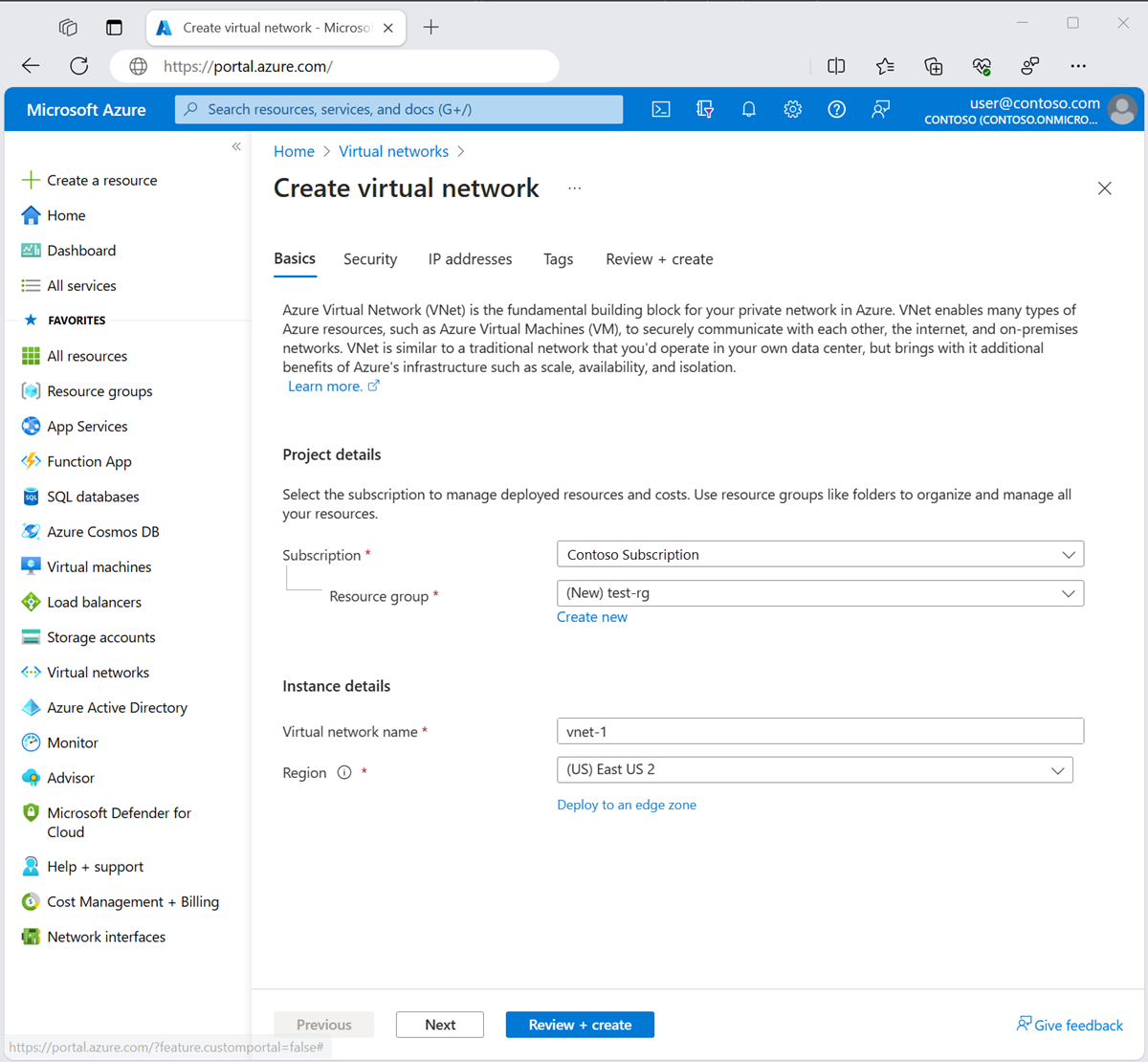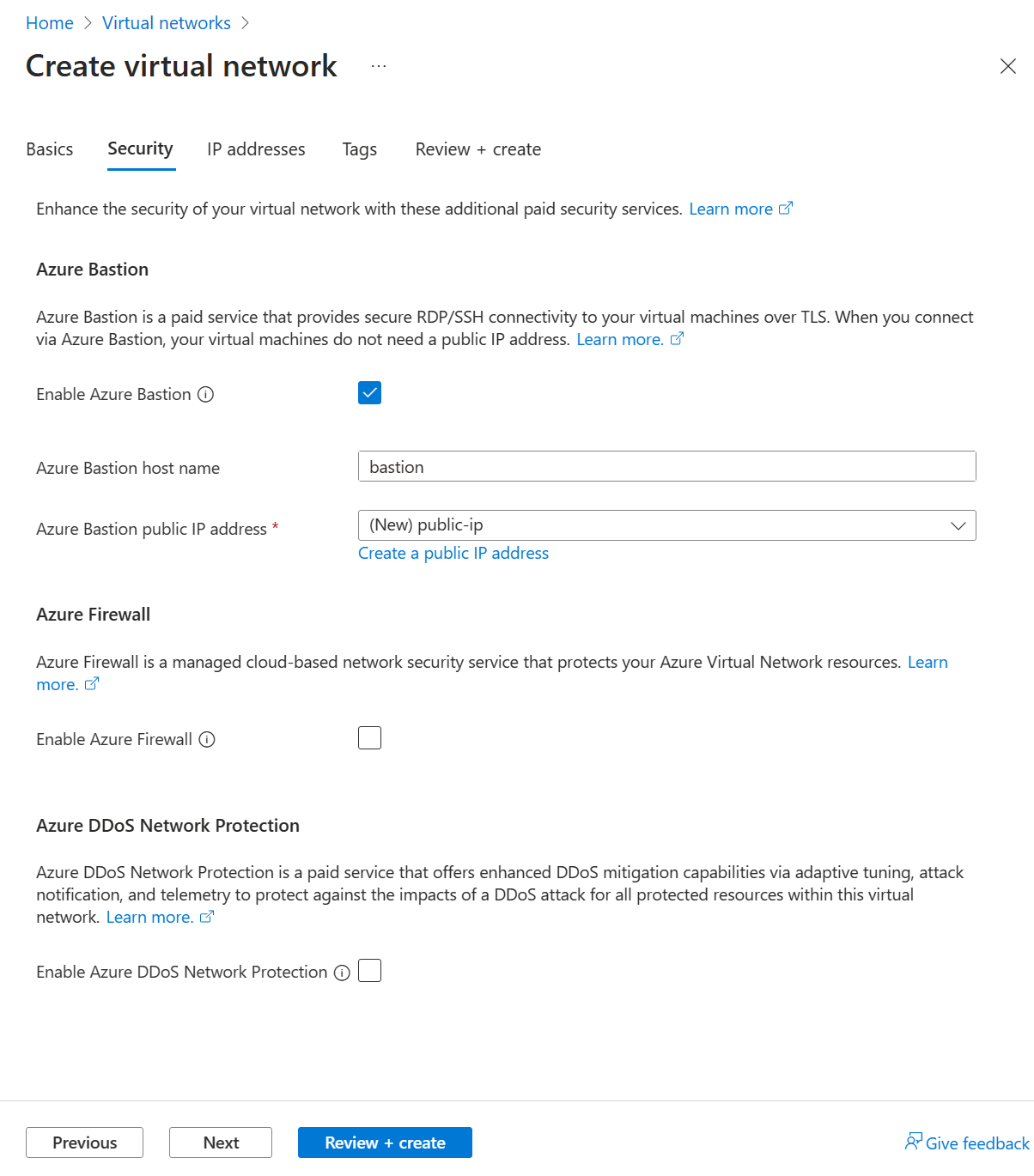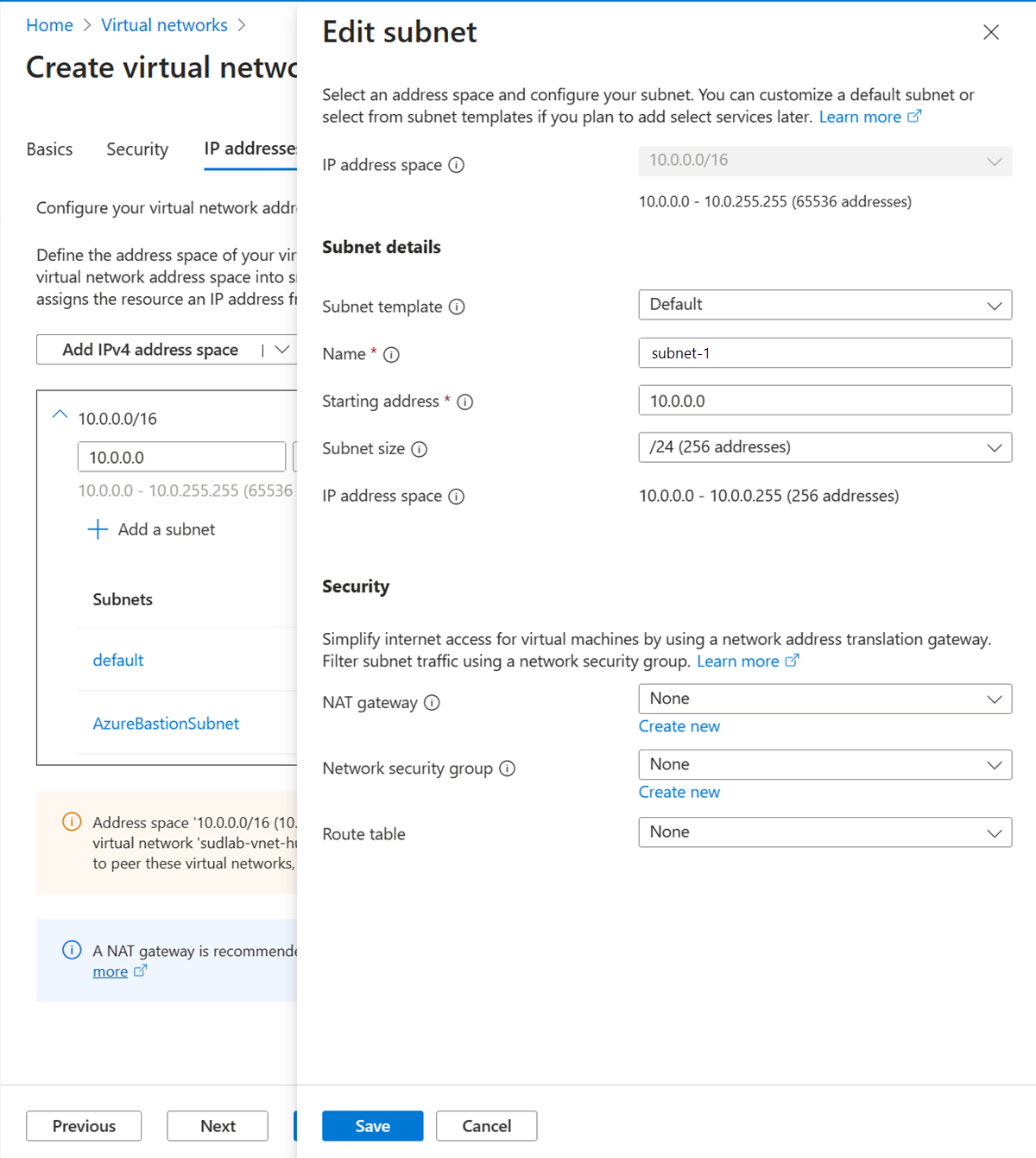Tutorial: Connect to an Azure SQL server using an Azure Private Endpoint using the Azure portal
Azure Private endpoint is the fundamental building block for Private Link in Azure. It enables Azure resources, like virtual machines (VMs), to privately and securely communicate with Private Link resources such as Azure SQL server.

In this tutorial, you learn how to:
- Create a virtual network and bastion host.
- Create a virtual machine.
- Create an Azure SQL server and private endpoint.
- Test connectivity to the SQL server private endpoint.
If you don't have an Azure subscription, create a free account before you begin.
Prerequisites
- An Azure subscription
Sign in to Azure
Sign in to the Azure portal.
Create a virtual network and an Azure Bastion host
The following procedure creates a virtual network with a resource subnet, an Azure Bastion subnet, and a Bastion host:
In the portal, search for and select Virtual networks.
On the Virtual networks page, select + Create.
On the Basics tab of Create virtual network, enter or select the following information:
Setting Value Project details Subscription Select your subscription. Resource group Select Create new. Enter test-rg for the name. Select OK. Instance details Name Enter vnet-1. Region Select East US 2. 
Select Next to proceed to the Security tab.
In the Azure Bastion section, select Enable Bastion.
Bastion uses your browser to connect to VMs in your virtual network over Secure Shell (SSH) or Remote Desktop Protocol (RDP) by using their private IP addresses. The VMs don't need public IP addresses, client software, or special configuration. For more information, see What is Azure Bastion?.
In Azure Bastion, enter or select the following information:
Setting Value Azure Bastion host name Enter bastion. Azure Bastion public IP address Select Create a public IP address. Enter public-ip-bastion in Name. Select OK. 
Select Next to proceed to the IP Addresses tab.
In the address space box in Subnets, select the default subnet.
In Edit subnet, enter or select the following information:
Setting Value Subnet details Subnet template Leave the default of Default. Name Enter subnet-1. Starting address Leave the default of 10.0.0.0. Subnet size Leave the default of /24 (256 addresses). 
Select Save.
Select Review + create at the bottom of the window. When validation passes, select Create.
Create test virtual machine
The following procedure creates a test virtual machine (VM) named vm-1 in the virtual network.
In the portal, search for and select Virtual machines.
In Virtual machines, select + Create, then Azure virtual machine.
On the Basics tab of Create a virtual machine, enter or select the following information:
Setting Value Project details Subscription Select your subscription. Resource group Select test-rg. Instance details Virtual machine name Enter vm-1. Region Select East US 2. Availability options Select No infrastructure redundancy required. Security type Leave the default of Standard. Image Select Ubuntu Server 22.04 LTS - x64 Gen2. VM architecture Leave the default of x64. Size Select a size. Administrator account Authentication type Select Password. Username Enter azureuser. Password Enter a password. Confirm password Reenter the password. Inbound port rules Public inbound ports Select None. Select the Networking tab at the top of the page.
Enter or select the following information in the Networking tab:
Setting Value Network interface Virtual network Select vnet-1. Subnet Select subnet-1 (10.0.0.0/24). Public IP Select None. NIC network security group Select Advanced. Configure network security group Select Create new. Enter nsg-1 for the name. Leave the rest at the defaults and select OK. Leave the rest of the settings at the defaults and select Review + create.
Review the settings and select Create.
Note
Virtual machines in a virtual network with a bastion host don't need public IP addresses. Bastion provides the public IP, and the VMs use private IPs to communicate within the network. You can remove the public IPs from any VMs in bastion hosted virtual networks. For more information, see Dissociate a public IP address from an Azure VM.
Note
Azure provides a default outbound access IP for VMs that either aren't assigned a public IP address or are in the backend pool of an internal basic Azure load balancer. The default outbound access IP mechanism provides an outbound IP address that isn't configurable.
The default outbound access IP is disabled when one of the following events happens:
- A public IP address is assigned to the VM.
- The VM is placed in the backend pool of a standard load balancer, with or without outbound rules.
- An Azure NAT Gateway resource is assigned to the subnet of the VM.
VMs that you create by using virtual machine scale sets in flexible orchestration mode don't have default outbound access.
For more information about outbound connections in Azure, see Default outbound access in Azure and Use Source Network Address Translation (SNAT) for outbound connections.
Create an Azure SQL server and private endpoint
In this section, you create a SQL server in Azure.
In the search box at the top of the portal, enter SQL. Select SQL databases in the search results.
In SQL databases, select + Create.
In the Basics tab of Create SQL Database, enter or select the following information:
Setting Value Project details Subscription Select your subscription. Resource group Select test-rg. Database details Database name Enter sql-db. Server Select Create new. Enter sql-server-1 in Server name (Server names must be unique, replace sql-server-1 with a unique value). Select (US) East US 2 in Location. Select Use SQL authentication. Enter a server admin sign-in and password. Select OK. Want to use SQL elastic pool? Select No. Workload environment Leave the default of Production. Backup storage redundancy Backup storage redundancy Select Locally redundant backup storage. Select Next: Networking.
In the Networking tab of Create SQL Database, enter or select the following information:
Setting Value Network connectivity Connectivity method Select Private endpoint. Private endpoints Select +Add private endpoint. Create private endpoint Subscription Select your subscription. Resource group Select test-rg. Location Select East US 2. Name Enter private-endpoint-sql. Target subresource Select SqlServer. Networking Virtual network Select vnet-1. Subnet Select subnet-1. Private DNS integration Integrate with private DNS zone Select Yes. Private DNS zone Leave the default of privatelink.database.windows.net. Select OK.
Select Review + create.
Select Create.
Important
When adding a Private endpoint connection, public routing to your Azure SQL server is not blocked by default. The setting "Deny public network access" under the "Firewall and virtual networks" blade is left unchecked by default. To disable public network access ensure this is checked.
Disable public access to Azure SQL logical server
For this scenario, assume you would like to disable all public access to your Azure SQL server, and only allow connections from your virtual network.
In the search box at the top of the portal, enter SQL server. Select SQL servers in the search results.
Select sql-server-1.
On the Networking page, select Public access tab, then select Disable for Public network access.
Select Save.
Test connectivity to private endpoint
In this section, you use the virtual machine you created in the previous steps to connect to the SQL server across the private endpoint.
In the search box at the top of the portal, enter Virtual machine. Select Virtual machines in the search results.
Select vm-1.
In Operations select Bastion.
Enter the username and password for the virtual machine.
Select Connect.
To verify name resolution of the private endpoint, enter the following command in the terminal window:
nslookup sql-server-1.database.windows.netYou receive a message similar to the following example. The IP address returned is the private IP address of the private endpoint.
Server: 127.0.0.53 Address: 127.0.0.53#53 Non-authoritative answer: sql-server-8675.database.windows.netcanonical name = sql-server-8675.privatelink.database.windows.net. Name:sql-server-8675.privatelink.database.windows.net Address: 10.1.0.4Install the SQL server command line tools from Install the SQL Server command-line tools sqlcmd and bcp on Linux. Proceed with the next steps after the installation is complete.
Use the following commands to connect to the SQL server you created in the previous steps.
Replace <server-admin> with the admin username you entered during the SQL server creation.
Replace <admin-password> with the admin password you entered during SQL server creation.
Replace sql-server-1 with the name of your SQL server.
sqlcmd -S sql-server-1.database.windows.net -U '<server-admin>' -P '<admin-password>'A SQL command prompt is displayed on successful sign in. Enter exit to exit the sqlcmd tool.
Clean up resources
When you finish using the resources that you created, you can delete the resource group and all its resources:
In the Azure portal, search for and select Resource groups.
On the Resource groups page, select the test-rg resource group.
On the test-rg page, select Delete resource group.
Enter test-rg in Enter resource group name to confirm deletion, and then select Delete.
Next steps
In this tutorial, you learned how to create:
Virtual network and bastion host.
Virtual machine.
Azure SQL server with private endpoint.
You used the virtual machine to test connectivity privately and securely to the SQL server across the private endpoint.
As a next step, you may also be interested in the Web app with private connectivity to Azure SQL Database architecture scenario, which connects a web application outside of the virtual network to the private endpoint of a database.
Feedback
Coming soon: Throughout 2024 we will be phasing out GitHub Issues as the feedback mechanism for content and replacing it with a new feedback system. For more information see: https://aka.ms/ContentUserFeedback.
Submit and view feedback for